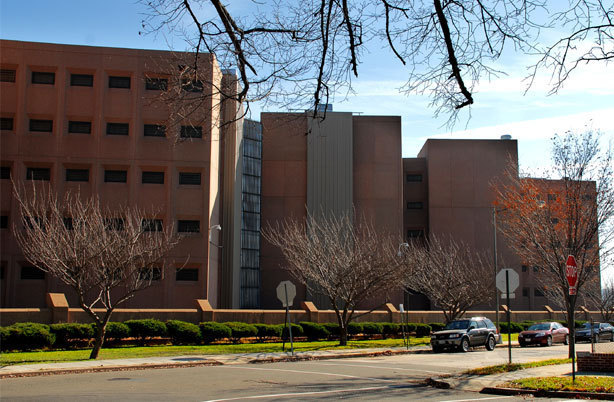Much has been written of late about the emergence of a bipartisan consensus on the need for criminal justice reform, encompassing both the White House and Congress. If this is true, the president and members of Congress would do well to start their reform efforts close to home at the District of Columbia jail.
The D.C. jail sits less than two miles east of Capitol Hill out of sight of the Mall and its sparkling monuments. This complex of buildings warehouses mostly poor people of color, many of whom are awaiting trial and have not been convicted of a crime. A scathing report on the jail system was produced recently by the Washington Lawyers’ Committee for Civil Rights and Urban Affairs in conjunction with the firm of Covington and Burling: D.C. Prisoners: Conditions of Confinement in the District of Columbia. The report found a crumbling infrastructure, poor mental health services, a high suicide rate, shamefully inadequate youth facilities, and an excessive use of solitary confinement.
Washington’s jail system is a complex comprised of two main sections: the Central Detention Facility (CDF), a deteriorating building dating back to the 1970s where most adults are held, and a smaller facility called the Correctional Treatment Facility (CTF) that houses men, women and children in individual cells, effectively in solitary confinement. The CDF and the CTF house pretrial detainees who cannot make bail, those awaiting transfer, and those convicted of misdemeanors. People convicted of a felony are transferred to a Federal Bureau of Prisons facility, where the District no longer has jurisdiction over them.
While the D.C. jail is operated by the D.C. Department of Corrections (DCDOC), the CTF is run on a long-term contract by the Corrections Corporation of America — the country’s largest private prison operation, which has come under increasing attack for its poorly run facilities.
The report describes in some detail just how bad the overall system is. D.C. inspectors found holes in the jail’s walls, water leaking in through cracks in the roofs, mold and cracked concrete. The report also states that children were largely mistreated and kept in solitary confinement, allegedly for their own safety, for extended periods of time. Additionally, between November 2012 and August 2013 four people at the D.C. jail committed suicide, bringing the DCDOC suicide rate to three times the national average. The report attributes the high rate to the failure of guards and jail staff to follow existing mental health policies.
The authors of the report also make clear that there is little in the way of oversight within the jail, either by the D.C. City Council or any other city agency. In fact, the authors were initially denied a copy of the contract between the DCDOC and CCA and obtained one only after lengthy efforts. In addition, when seeking one report from the city’s Department of Health, the authors were initially told that no such report existed and had to prove that it did by obtaining the report through other means.
The CCA operation poses additional problems. The CTF originally belonged to the District, but in 1997 the cash-strapped city sold part of its jail system to CCA for $52 million and then leased it back for $2.8 million a year to the company in a contract that ends in 2017. Through this deal CCA made a 31 percent profit on its management fee alone.
While CCA may be a leader in profits margins, they are clearly unfit to run a criminal rehabilitation program. The report highlights a case of a deaf man with HIV who filed a suit in federal district court against the District claiming CCA jailers wouldn’t give him the medical care he required. The man had been sentenced to 60 days in jail for a domestic dispute, and when he inquired about medical care during his incarceration jailers place him in solitary confinement. When not in solitary confinement the man was kept in handcuffs and denied the ability to speak to lawyers, his family or his partner in sign language. A spokesperson for the CCA told the Washington Post that the company took the case of the deaf man “very seriously” and were working “diligently to accommodate any special needs” of people held at their facilities.
The report also found the youth facilities severely wanting, with an almost complete lack of any programming for juveniles held in the jail and an excessive use of solitary confinement. A Solitary Watch investigation in 2013 also found that children charged as adults and held in the D.C. jails often spent months on end locked down 23 hours a day in barren cells, most often for “their own protection.” Children are further isolated from their families by often being forced to visit via video stream rather than in person.
In order to address these inadequacies the authors propose a series of recommendations. The most dramatic of these is to demolish both the CDF and the CTF, which are physically beyond repair and no longer meet what the report calls “the District’s true correctional needs.”
A new facility could be designed to address the prisoner population the District expects to have and provide for the different prisoner populations, including men and women, those awaiting trial, those post-conviction awaiting transfer to the BOP, parole violators, juveniles of both sexes, individuals within each population who have special physical or mental health needs (including suicide monitoring), and individuals of all ages and gender who could benefit from substance abuse programming such as the SRTP (Secure Residential Treatment Program).
People involved in the project say the immediate aim is to get the D.C. City Council to order a study and then use that study to figure out who actually is in the jail system, what they did to get there and for how long. They then hope to see new rules written that would increase the number of people who get released on their own recognizance, reducing the number who are held in jail for not being able to raise relatively small amounts of bail. The information from the study might also help advocates argue for sentencing reform and reduce the length of time people stay in jail.
The first step toward these goals has now been taken, as the D.C. City Council recently voted to spend $150,000 studying the future of the jail system. There have been several prior studies, however, none of them bearing results nearly as dramatic as the Washington Lawyers’ Committee recommends.
Another report recommendation is that the District allow its contract with CCA, which expires in 2017, to lapse and kick the company out of the D.C. prison business. The company is a tough, adroit political infighter that spends millions a year lobbying at the federal, state and local levels, and has made contributions to District mayoral and city council races. If CCA goes, it likely will not go quietly.









